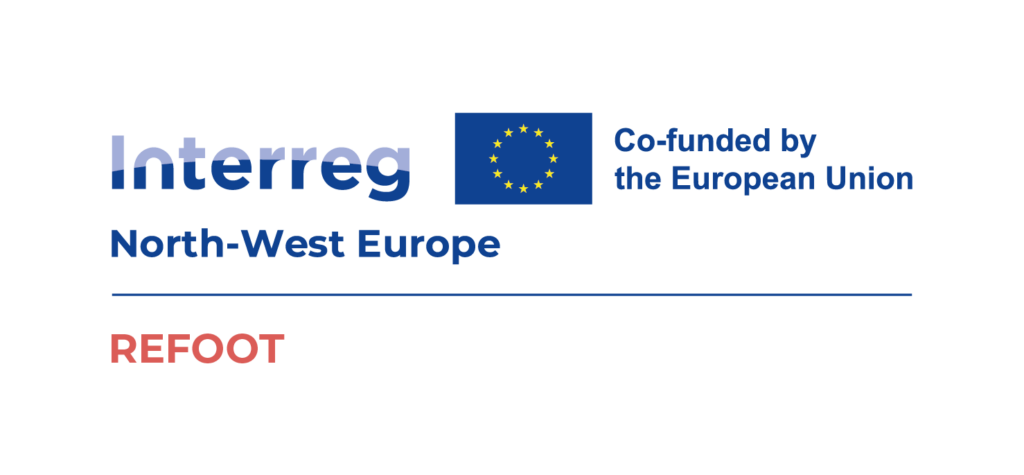The LRE Foundation and its partners are currently implementing the project ‘Retracing the Footsteps: A Transnational Journey of Canadian Liberation in WWII (REFOOT)’. Supported by the European Interreg North-West Europe programme, the initiative aims to develop a transnational hiking trail that traces the route taken by Canadian soldiers during the liberation of Western Europe in the Second World War. The trail will stretch from the beaches of Normandy in France, through Belgium, and into the Netherlands.
This remembrance and tourism initiative is being developed in collaboration with several key partners, including the Juno Beach Centre in Normandy (France), the For Freedom Museum in Knokke (Belgium), and LRE France. Leading the coordination and implementation of the trail in France is Isabelle Lebreton, Managing Director of LRE France. We spoke with her to learn more about her role in the project and the progress made so far.
What is the goal of the REFOOT project?
This project aims to develop the first transnational hiking trail that highlights the Canadian effort during WWII. The trail will span from France to Germany, connecting key historical sites along the way. With support from the European Interreg North-West Europe programme, we aim to promote this trail as a more sustainable and meaningful way to discover history.
What are your tasks within the project?
One of my main responsibilities is defining the trail itself. With support from the French Hiking Federation, one of our associated partners, I have been identifying suitable hiking paths across France. A key challenge has been aligning existing trails with historical accuracy, something that is not always straightforward.
I also developed the map for this trail and contributed to the implementation of the markers that will be placed at some sites along the way called Vectors of Memory. As the project coordinator for France, I review historical content to ensure consistency with existing points of interest. Finally, I support the project’s dissemination by sharing updates within our network and maintaining communication with our partners.
What makes this project meaningful for you?
This project makes a lot of sense to me and, honestly, it feels like something we should have done much earlier. Canada’s role in the war is often underrepresented in WWII history. Through this trail it feels like we are giving that effort a tangible place, and in doing so, paying tribute to all the Canadian soldiers who helped liberate Europe. I also value that we are sharing these stories in an innovative and sustainable way on the liberationroute.com website and app, which helps us reach a wider audience, especially younger generations.
Why is the project so important for local communities and future generations?
The Canadian Trail offers a unique opportunity to explore history in depth—highlighting both well-known and lesser-known sites marked by the Canadian liberation. Because the trail runs close to local communities, it becomes both accessible and meaningful to those who live nearby.
Historical content is available through the Liberation Route app, making it easy for visitors to engage with the stories behind each site. In this way, we can also reach younger audiences—demonstrating that understanding the past is essential to shaping the future, and connecting this message to broader themes such as sustainability and climate awareness.
I truly hope this new way of discovering history will inspire many to walk the Canadian Trail.
Can you share a special story you’ve discovered during your work on the project?
During our research we found a very rare picture. It shows the graves of two Canadian soldiers, surrounded by local children in what seems to be a private garden in Belbeuf, Normandy. A small ceremony appears to be taking place. The photo was given to us by Mrs Dumont, a Frensh civilian and it’s quite unusual. Because even though soldiers were often buried in fields, it’s rare to find such a moment captured.
We later discovered the graves belonged to Major Ramsay and Lance Bombardier Karos of the Canadian 2nd Infantry Division. On August 31st, 1944, they were scouting locations for artillery when they encountered a German lorry. Karros was killed instantly and Ramsay died later in the hospital. The graves were tended by villagers until October 1945. Mrs Dumont sent a letter on 6 December 1945 to the Department of National Defence, asking if the photo could be sent to the soldier’s families. This is very touching because it shows, despite everything that was going on, the care, respect and gratitude that was held by the French civilians towards those that liberated the country. Today, both men are buried in the Calais Canadian Cemetery.
The Canadian Trails allowed us to uncover and share this picture and the story behind it. We’re proud to soon be able to share this personal event as part of the Liberation Route Europe.
What do you hope people take away from the Canadian Trails?
I hope many people will walk this trail and discover or learn more about the Canadian effort. That they will take home the stories of the women and men who fought to liberate Europe and share them with others. Above all, I hope young people will see that history can be learned in a new and meaningful way.

